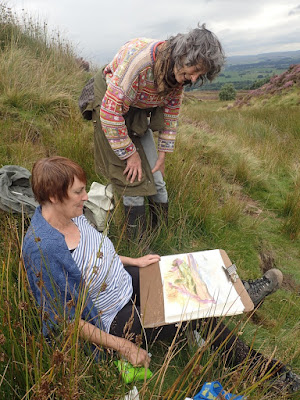Craven Conservation Group members set off to find out. - Sat 19 - a windy wet day in August.
 On the way we found the patch of Spring Sandwort flowering with its pink anthers. (Yes is was the Sandwort - obviously thought it was spring and not summer weather)
On the way we found the patch of Spring Sandwort flowering with its pink anthers. (Yes is was the Sandwort - obviously thought it was spring and not summer weather)
Our equivalent of the professor was Sharon and Peter Flint.
We left the cars just south of the Tarn and marched down to find where the outflow stream would be sinking today. A little way back up we found a wooden post lying in the stream. Sharon, with help, enthusiastically levered it up to see what was clinging on to it. "Such wood adds diversity" she said. "When beavers gnaw at trees and fell them, the trunks fall into streams and add diversity."
We put our finds in a tub - and then collected more organisms from the mosses and algae on the rocks of the stream.
We found a longer than wide snail: Bithynia tentaculata
Everyone except me (for some reason) saw a Fingernail clam: Sphaerium corneum. These are bivalves (have two shells) Their primary food sources are diatoms and other phytoplankton
Sharon told us how they are filter feeds and "hoover up" gunge, and keep the lake clean.
Here is a Mayfly nymph called Serratella ignita (Thanks to Sharon for the picture)
We also found some stonefly nymphs. Mayfly nymphs have three tails and can swim and so move very fast in water. Stoneflies just walk or run in water. The stonefly nymphs we found were quite small - but they would be quite young, having just been laid earlier n the summer. They would grow bigger and shed their skins several times before next summer.
For one species we found Sharon said the male did not fly. When it emerges it crawls around on the rocks, waiting for a female fly and visit it. The females emerge from the water with their eggs ready developed.They visit a male and then then eventually crawl back into the water to lay their eggs.
This is a picture of an empty pupa case of the caddis Ceraclea nigronervosa The stone particles are held together by silky material. If the case had been closed, the pupa would have been inside. When the pupa needs to emerge it chews its way out. These cases are relatively flat and can fit under rocks.

Oh, Sharon has just sent me a photo with the larva inside
There are 199 different species of Caddis in Britain, and one third of them can be found in and near Malham Tarn. 70. Not bad!!
The Yorkshire Naturalists Union did a lot of surveys and research over a period of five years in Malham Tarn in 1960s(?)
Peter and Sharon spent a year last year or rwo
Below is a cranefly larva or leather jacket. (See video) "It bit me" said the finder. "Well a few cranefly larvae are carnivorous - though many eat plant roots And and a few do live in water " said Peter.
Due to concern that we might get sunstroke due to the intense heat, (???) we had a shorter trip than planned - but hope to arrange another day shortly. Let us know if you would like to come.
http://www.craven-conservation-group.org.uk
http://www.craven-conservation-group.org.uk















